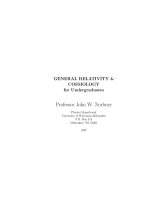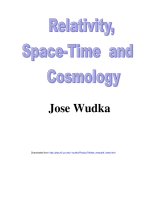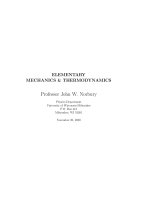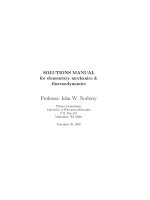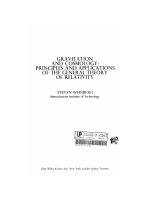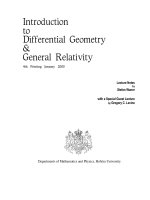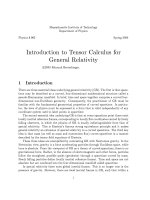- Trang chủ >>
- Khoa Học Tự Nhiên >>
- Vật lý
General relativity and cosmology for undergraduates j norbury
Bạn đang xem bản rút gọn của tài liệu. Xem và tải ngay bản đầy đủ của tài liệu tại đây (747.96 KB, 116 trang )
GENERAL RELATIVITY &
COSMOLOGY
for Undergraduates
Professor John W. Norbury
Physics Department
University of Wisconsin-Milwaukee
P.O. Box 413
Milwaukee, WI 53201
1997
Contents
1 NEWTONIAN COSMOLOGY
1.1 Introduction . . . . . . . . . . . . . .
1.2 Equation of State . . . . . . . . . . .
1.2.1 Matter . . . . . . . . . . . . .
1.2.2 Radiation . . . . . . . . . . .
1.3 Velocity and Acceleration Equations
1.4 Cosmological Constant . . . . . . . .
1.4.1 Einstein Static Universe . . .
.
.
.
.
.
.
.
.
.
.
.
.
.
.
.
.
.
.
.
.
.
.
.
.
.
.
.
.
.
.
.
.
.
.
.
2 APPLICATIONS
2.1 Conservation laws . . . . . . . . . . . . . . .
2.2 Age of the Universe . . . . . . . . . . . . . .
2.3 Inflation . . . . . . . . . . . . . . . . . . . . .
2.4 Quantum Cosmology . . . . . . . . . . . . . .
2.4.1 Derivation of the Schră
odinger equation
2.4.2 Wheeler-DeWitt equation . . . . . . .
2.5 Summary . . . . . . . . . . . . . . . . . . . .
2.6 Problems . . . . . . . . . . . . . . . . . . . .
2.7 Answers . . . . . . . . . . . . . . . . . . . . .
2.8 Solutions . . . . . . . . . . . . . . . . . . . .
3 TENSORS
3.1 Contravariant and Covariant Vectors
3.2 Higher Rank Tensors . . . . . . . . .
3.3 Review of Cartesian Tensors . . . . .
3.4 Metric Tensor . . . . . . . . . . . . .
3.4.1 Special Relativity . . . . . . .
3.5 Christoffel Symbols . . . . . . . . . .
.
.
.
.
.
.
.
.
.
.
.
.
.
.
.
.
.
.
.
.
.
.
.
.
1
www.pdfgrip.com
.
.
.
.
.
.
.
.
.
.
.
.
.
.
.
.
.
.
.
.
.
.
.
.
.
.
.
.
.
.
.
.
.
.
.
.
.
.
.
.
.
.
.
.
.
.
.
.
.
.
.
.
.
.
.
.
.
.
.
.
.
.
.
.
.
.
.
.
.
.
.
.
.
.
.
.
.
.
.
.
.
.
.
.
.
.
.
.
.
.
.
.
.
.
.
.
.
.
.
.
.
.
.
.
.
.
.
.
.
.
.
.
.
.
.
.
.
.
.
.
.
.
.
.
.
.
.
.
.
.
.
.
.
.
.
.
.
.
.
.
.
.
.
.
.
.
.
.
.
.
.
.
.
.
.
.
.
.
.
.
.
.
.
.
.
.
.
.
.
.
.
.
.
.
.
.
.
.
.
.
.
.
.
.
.
.
.
.
.
.
.
.
.
.
.
.
.
5
5
5
6
6
7
9
11
.
.
.
.
.
.
.
.
.
.
13
13
14
15
16
16
17
18
19
20
21
.
.
.
.
.
.
23
23
26
27
28
30
31
2
CONTENTS
3.6
3.7
3.8
3.9
3.10
3.11
Christoffel Symbols and Metric Tensor
Riemann Curvature Tensor . . . . . .
Summary . . . . . . . . . . . . . . . .
Problems . . . . . . . . . . . . . . . .
Answers . . . . . . . . . . . . . . . . .
Solutions . . . . . . . . . . . . . . . .
.
.
.
.
.
.
.
.
.
.
.
.
.
.
.
.
.
.
.
.
.
.
.
.
.
.
.
.
.
.
.
.
.
.
.
.
.
.
.
.
.
.
.
.
.
.
.
.
.
.
.
.
.
.
.
.
.
.
.
.
.
.
.
.
.
.
.
.
.
.
.
.
.
.
.
.
.
.
36
38
39
40
41
42
4 ENERGY-MOMENTUM TENSOR
45
4.1 Euler-Lagrange and Hamilton’s Equations . . . . . . . . . . . 45
4.2 Classical Field Theory . . . . . . . . . . . . . . . . . . . . . . 47
4.2.1 Classical Klein-Gordon Field . . . . . . . . . . . . . . 48
4.3 Principle of Least Action . . . . . . . . . . . . . . . . . . . . 49
4.4 Energy-Momentum Tensor for Perfect Fluid . . . . . . . . . . 49
4.5 Continuity Equation . . . . . . . . . . . . . . . . . . . . . . . 51
4.6 Interacting Scalar Field . . . . . . . . . . . . . . . . . . . . . 51
4.7 Cosmology with the Scalar Field . . . . . . . . . . . . . . . . 53
4.7.1 Alternative derivation . . . . . . . . . . . . . . . . . . 55
4.7.2 Limiting solutions . . . . . . . . . . . . . . . . . . . . 56
4.7.3 Exactly Solvable Model of Inflation . . . . . . . . . . . 59
4.7.4 Variable Cosmological Constant . . . . . . . . . . . . . 61
4.7.5 Cosmological constant and Scalar Fields . . . . . . . . 63
4.7.6 Clarification . . . . . . . . . . . . . . . . . . . . . . . . 64
4.7.7 Generic Inflation and Slow-Roll Approximation . . . . 65
4.7.8 Chaotic Inflation in Slow-Roll Approximation . . . . . 67
4.7.9 Density Fluctuations . . . . . . . . . . . . . . . . . . . 72
4.7.10 Equation of State for Variable Cosmological Constant 73
4.7.11 Quantization . . . . . . . . . . . . . . . . . . . . . . . 77
4.8 Problems . . . . . . . . . . . . . . . . . . . . . . . . . . . . . 80
5 EINSTEIN FIELD EQUATIONS
5.1 Preview of Riemannian Geometry . . . . . .
5.1.1 Polar Coordinate . . . . . . . . . . .
5.1.2 Volumes and Change of Coordinates
5.1.3 Differential Geometry . . . . . . . .
5.1.4 1-dimesional Curve . . . . . . . . . .
5.1.5 2-dimensional Surface . . . . . . . .
5.1.6 3-dimensional Hypersurface . . . . .
5.2 Friedmann-Robertson-Walker Metric . . . .
5.2.1 Christoffel Symbols . . . . . . . . . .
www.pdfgrip.com
.
.
.
.
.
.
.
.
.
.
.
.
.
.
.
.
.
.
.
.
.
.
.
.
.
.
.
.
.
.
.
.
.
.
.
.
.
.
.
.
.
.
.
.
.
.
.
.
.
.
.
.
.
.
.
.
.
.
.
.
.
.
.
.
.
.
.
.
.
.
.
.
.
.
.
.
.
.
.
.
.
.
.
.
.
.
.
.
.
.
83
84
84
85
88
89
92
96
99
101
CONTENTS
5.3
3
5.2.2 Ricci Tensor . . . . . . . . . . . . . .
5.2.3 Riemann Scalar and Einstein Tensor
5.2.4 Energy-Momentum Tensor . . . . .
5.2.5 Friedmann Equations . . . . . . . .
Problems . . . . . . . . . . . . . . . . . . .
.
.
.
.
.
.
.
.
.
.
.
.
.
.
.
.
.
.
.
.
.
.
.
.
.
.
.
.
.
.
.
.
.
.
.
.
.
.
.
.
.
.
.
.
.
.
.
.
.
.
102
103
104
104
105
6 Einstein Field Equations
107
7 Weak Field Limit
109
8 Lagrangian Methods
111
www.pdfgrip.com
4
CONTENTS
www.pdfgrip.com
Chapter 1
NEWTONIAN
COSMOLOGY
1.1
Introduction
Many of the modern ideas in cosmology can be explained without the need
to discuss General Relativity. The present chapter represents an attempt to
do this based entirely on Newtonian mechanics. The equations describing
the velocity (called the Friedmann equation) and acceleration of the universe
are derived from Newtonian mechanics and also the cosmological constant
is introduced within a Newtonian framework. The equations of state are
also derived in a very simple way. Applications such as conservation laws,
the age of the universe and the inflation, radiation and matter dominated
epochs are discussed.
1.2
Equation of State
In what follows the equation of state for non-relativistic matter and radiation
will be needed. In particular an expression for the rate of change of density,
ρ,
˙ will be needed in terms of the density ρ and pressure p. (The definition
x˙ ≡ dx
dt , where t is time, is being used.) The first law of thermodynamics is
dU + dW = dQ
(1.1)
where U is the internal energy, W is the work and Q is the heat transfer.
Ignoring any heat transfer and writing dW = F dr = pdV where F is the
5
www.pdfgrip.com
6
CHAPTER 1. NEWTONIAN COSMOLOGY
force, r is the distance, p is the pressure and V is the volume, then
dU = −pdV.
(1.2)
Assuming that ρ is a relativistic energy density means that the energy is
expressed as
U = ρV
(1.3)
from which it follows that
U˙ = ρV
˙ + ρV˙ = −pV˙
(1.4)
where the term on the far right hand side results from equation (1.2). Writing
˙
V ∝ r3 implies that VV = 3 rr˙ . Thus
ρ˙ = −3(ρ + p)
1.2.1
r˙
r
(1.5)
Matter
Writing the density of matter as
ρ=
M
4
3
3 πr
(1.6)
it follows that
dρ
r˙
r˙ = −3ρ
(1.7)
dr
r
so that by comparing to equation (1.5), it follows that the equation of state
for matter is
p = 0.
(1.8)
ρ˙ ≡
This is the same as obtained from the ideal gas law for zero temperature.
Recall that in this derivation we have not introduced any kinetic energy, so
we are talking about zero temperature.
1.2.2
Radiation
The equation of state for radiation can be derived by considering radiation
modes in a cavity based on analogy with a violin string [12]. For a standing
wave on a string fixed at both ends
L=
www.pdfgrip.com
nλ
2
(1.9)
1.3. VELOCITY AND ACCELERATION EQUATIONS
7
where L is the length of the string, λ is the wavelength and n is a positive
integer (n = 1, 2, 3.....). Radiation travels at the velocity of light, so that
c = fλ = f
2L
n
(1.10)
n
c into Planck’s formula
where f is the frequency. Thus substituting f = 2L
U =h
¯ ω = hf , where h is Planck’s constant, gives
U=
nhc 1
∝ V −1/3 .
2 L
(1.11)
Using equation (1.2) the pressure becomes
p≡−
dU
1U
=
.
dV
3V
(1.12)
Using ρ = U/V , the radiation equation of state is
1
p = ρ.
3
(1.13)
It is customary to combine the equations of state into the form
p=
γ
ρ
3
(1.14)
where γ ≡ 1 for radiation and γ ≡ 0 for matter. These equations of state
are needed in order to discuss the radiation and matter dominated epochs
which occur in the evolution of the Universe.
1.3
Velocity and Acceleration Equations
The Friedmann equation, which specifies the speed of recession, is obtained
by writing the total energy E as the sum of kinetic plus potential energy
terms (and using M = 43 πr3 ρ )
1
Mm
8πG
1
E = T + V = mr˙ 2 − G
= mr2 (H 2 −
ρ)
2
r
2
3
(1.15)
where the Hubble constant H ≡ rr˙ , m is the mass of a test particle in the
potential energy field enclosed by a gas of dust of mass M , r is the distance
from the center of the dust to the test particle and G is Newton’s constant.
www.pdfgrip.com
8
CHAPTER 1. NEWTONIAN COSMOLOGY
Recall that the escape velocity is just vescape =
the above equation can also be written
2GM
r
=
8πG
2
3 ρr ,
so that
2
r˙ 2 = vescape
− k 13 − 2
(1.16)
with k ≡ − 2E
m . The constant k can either be negative, zero or positive
corresponding to the total energy E being positive, zero or negative. For
a particle in motion near the Earth this would correspond to the particle
escaping (unbound), orbiting (critical case) or returning (bound) to Earth
because the speed r˙ would be greater, equal to or smaller than the escape
speed vescape . Later this will be analagous to an open, flat or closed universe.
Equation (1.15) is re-arranged as
H2 =
8πG
2E
.13 − 3
ρ+
3
mr2
(1.17)
2E
Defining k ≡ − ms
2 and writing the distance in terms of the scale factor R
and a constant length s as r(t) ≡ R(t)s, it follows that
giving the Friedmann equation
R˙
8πG
k
H 2 ≡ ( )2 =
2
R
3
R
r
r
=
R
R
and
ră
r
=
ă
R
R,
(1.18)
which specifies the speed of recession. The scale factor is introduced because
in General Relativity it is space itself which expands [19]. Even though this
equation is derived for matter, it is also true for radiation. (In fact it is also
true for vacuum, with Λ ≡ 8πGρvac , where Λ is the cosmological constant
and ρvac is the vacuum energy density which just replaces the ordinary density. This is discussed later.) Exactly the same equation is obtained from
the general relativistic Einstein field equations [13]. According to Guth [10],
k can be rescaled so that instead of being negative, zero or positive it takes
on the values −1, 0 or +1. From a Newtonian point of view this corresponds
to unbound, critical or bound trajectories as mentioned above. From a geometric, general relativistic point of view this corresponds to an open, flat or
closed universe.
In elementary mechanics the speed v of a ball dropped from a height r
√
is evaluated from the conservation of energy equation as v = 2gr, where
g is the acceleration due to gravity. The derivation shown above is exactly
analagous to such a calculation. Similarly the acceleration a of the ball is
calculated as a = g from Newtons equation F = mă
r, where F is the force
www.pdfgrip.com
1.4. COSMOLOGICAL CONSTANT
and the acceleration is ră
from Newtons equation
d2 r
.
dt2
G
Again using M = 43 r3 and
ră
r
9
The acceleration for the universe is obtained
Mm
= mă
r.13 5
r2
=
ă
R
R
(1.19)
gives the acceleration equation
ă
F
ră R
4πG
≡ ≡
=−
ρ.
mr
r
R
3
(1.20)
However because M = 43 πr3 ρ was used, it is clear that this acceleration
equation holds only for matter. In our example of the falling ball instead of
the acceleration being obtained from Newton’s Law, it can also be obtained
dv
by taking the time derivative of the energy equation to give a = dv
dt = v dr =
√
√
1
( 2gr)( 2g 2√r ) = g. Similarly, for the general case one can take the time
derivative of equation (1.18) (valid for matter and radiation)
d 2
ă = 8G d (R2 ).
R = 2R R
dt
3 dt
(1.21)
Upon using equation (1.5) the acceleration equation is obtained as
ă
R
4G
4G
=
( + 3p) = −
(1 + γ)ρ
R
3
3
(1.22)
which reduces to equation (1.20) for the matter equation of state (γ = 0).
Exactly the same equation is obtained from the Einstein field equations [13].
1.4
Cosmological Constant
In both Newtonian and relativistic cosmology the universe is unstable to
gravitational collapse. Both Newton and Einstein believed that the Universe
is static. In order to obtain this Einstein introduced a repulsive gravitational
force, called the cosmological constant, and Newton could have done exactly
the same thing, had he believed the universe to be finite.
In order to obtain a possibly zero acceleration, a positive term (conventionally taken as Λ3 ) is added to the acceleration equation (1.22) as
ă
R
4G
=
( + 3p) +
R
3
3
www.pdfgrip.com
(1.23)
10
CHAPTER 1. NEWTONIAN COSMOLOGY
which, with the proper choice of Λ can give the required zero acceleration
for a static universe. Again exactly the same equation is obtained from the
Einstein field equations [13]. What has been done here is entirely equivalent
to just adding a repulsive gravitational force in Newton’s Law. The question
now is how this repulsive force enters the energy equation (1.18). Identifying
the force from
ă
Frepulsive
ră R
=
(1.24)
r
R
mr
3
and using
dV
Frepulsive = mr
(1.25)
3
dr
gives the potential energy as
Vrepulsive = −
1Λ 2
mr
23
(1.26)
which is just a repulsive simple harmonic oscillator. Substituting this into
the conservation of energy equation
1
M m 1 Λ 2 1 2 2 8πG
Λ
E = T + V = mr˙ 2 − G
−
mr = mr (H −
ρ − ) (1.27)
2
r
23
2
3
3
gives
R˙
8πG
Λ
k
H 2 ≡ ( )2 =
ρ− 2 + .
R
3
R
3
(1.28)
Equations (1.28) and (1.23) constitute the fundamental equations of motion
that are used in all discussions of Friedmann models of the Universe. Exactly
the same equations are obtained from the Einstein field equations [13].
Let us comment on the repulsive harmonic oscillator obtained above.
Recall one of the standard problems often assigned in mechanics courses.
The problem is to imagine that a hole has been drilled from one side of the
Earth, through the center and to the other side. One is to show that if a
ball is dropped into the hole, it will execute harmonic motion. The solution
is obtained by noting that whereas gravity is an inverse square law for point
masses M and m separated by a distance r as given by F = G Mr2m , yet if one
of the masses is a continous mass distribution represented by a density then
F = G 43 πρmr. The force rises linearly as the distance is increased because
the amount of matter enclosed keeps increasing. Thus the gravitational force
for a continuous mass distribution rises like Hooke’s law and thus oscillatory
solutions are encountered. This sheds light on our repulsive oscillator found
www.pdfgrip.com
1.4. COSMOLOGICAL CONSTANT
11
above. In this case we want the gravity to be repulsive, but the cosmological
constant acts just like the uniform matter distribution.
Finally authors often write the cosmological constant in terms of a vacuum energy density as Λ ≡ 8πGρvac so that the velocity and acceleration
equations become
R˙
8πG
Λ
k
k
8πG
H 2 ≡ ( )2 =
2 + =
( + vac ) 2
R
3
R
3
3
R
(1.29)
ă
R
4G
4G
8G
=
(1 + γ)ρ + = −
(1 + γ)ρ +
ρvac .
R
3
3
3
3
(1.30)
and
1.4.1
Einstein Static Universe
Although we have noted that the cosmological constant provides repulsion,
it is interesting to calculate its exact value for a static universe [14, 15]. The
ă = 0.
Einstein static universe requires R = R0 = constant and thus R = R
ă
The case R = 0 will be examined first. From equation (1.23) this requires
that
Λ = 4πG(ρ + 3p) = 4πG(1 + γ)ρ.
(1.31)
If there is no cosmological constant (Λ = 0) then either ρ = 0 which is an
empty universe, or p = − 13 ρ which requires negative pressure. Both of these
alternatives were unacceptable to Einstein and therefore he concluded that
a cosmological constant was present, i.e. Λ = 0. From equation (1.31) this
implies
Λ
ρ=
(1.32)
4πG(1 + γ)
and because ρ is positive this requires a positive Λ. Substituting equation (1.32) into equation (1.28) it follows that
Λ=
3(1 + γ) R˙ 2
k
[( ) + 2 ].
3+γ
R0
R0
(1.33)
Now imposing R˙ = 0 and assuming a matter equation of state (γ = 0)
implies Λ = Rk2 . However the requirement that Λ be positive forces k = +1
0
giving
1
Λ = 2 = constant.
(1.34)
R0
www.pdfgrip.com
12
CHAPTER 1. NEWTONIAN COSMOLOGY
Thus the cosmological constant is not any old value but rather simply the
inverse of the scale factor squared, where the scale factor has a fixed value
in this static model.
www.pdfgrip.com
Chapter 2
APPLICATIONS
2.1
Conservation laws
Just as the Maxwell equations imply the conservation of charge, so too do
our velocity and acceleration equations imply conservation of energy. The
energy-momentum conservation equation is derived by setting the covariant
derivative of the energy momentum tensor equal to zero. The same result is
achieved by taking the time derivative of equation (1.29). The result is
ρ˙ + 3(ρ + p)
R˙
= 0.
R
(2.1)
This is identical to equation (1.5) illustrating the intersting connection betweeen thermodynamics and General Relativity that has been discussed recently [16]. The point is that we used thermodynamics to derive our velocity
and acceleration equations and it is no surprise that the thermodynamic formula drops out again at the end. However, the velocity and acceleration
equations can be obtained directly from the Einstein field equations. Thus
the Einstein equations imply this thermodynamic relationship in the above
equation.
The above equation can also be written as
d
dR3
(ρR3 ) + p
=0
dt
dt
(2.2)
and from equation (1.14), 3(ρ + p) = (3 + γ)ρ, it follows that
d
(ρR3+γ ) = 0.
dt
13
www.pdfgrip.com
(2.3)
14
CHAPTER 2. APPLICATIONS
Integrating this we obtain
ρ=
c
R3+γ
(2.4)
where c is a constant. This shows that the density falls as R13 for matter and
1
for radiation as expected.
R4
Later we shall use these equations in a different form as follows. From
equation (2.1),
1
ρ + 3(ρ + p) = 0
(2.5)
R
where primes denote derivatives with respect to R, i.e. x ≡ dx/dR. Alternatively
d
(2.6)
(ρR3 ) + 3pR2 = 0
dR
so that
1
R3+γ
d
(ρR3+γ ) = 0
dR
(2.7)
which is consistent with equation (2.4)
2.2
Age of the Universe
Recent measurements made with the Hubble space telescope [17] have determined that the age of the universe is younger than globular clusters. A
possible resolution to this paradox involves the cosmological constant [18].
We illustrate this as follows.
Writing equation (1.28) as
8πG
R˙ 2 =
(ρ + ρvac )R2 − k
3
(2.8)
the present day value of k is
k=
8πG
(ρ0 + ρ0vac )R02 − H02 R02
3
(2.9)
˙
R 2
with H 2 ≡ ( R
) . Present day values of quantities have been denoted with a
subscript 0. Substituting equation (2.9) into equation (2.8) yields
8πG
R˙ 2 =
(ρR2 − ρ0 R02 + ρvac R2 − ρ0vac R02 ) − H02 R02 .
3
www.pdfgrip.com
(2.10)
2.3. INFLATION
15
Integrating gives the expansion age
R0
T0 =
dR
=
R˙
R0
dR
.
− ρ0 R02 + ρvac R2 − ρ0vac R02 ) − H02 R02
(2.11)
For the cosmological constant ρvac = ρ0vac and because R2 < R02 then a
non zero cosmological constant will give an age larger than would have been
obtained were it not present. Our aim here is simply to show that the
inclusion of a cosmological constant gives an age which is larger than if no
constant were present.
0
2.3
0
8πG
2
3 (ρR
Inflation
In this section only a flat k = 0 universe will be discussed. Results for
an open or closed universe can easily be obtained and are discussed in the
references [13].
Currently the universe is in a matter dominated phase whereby the dominant contribution to the energy density is due to matter. However the early
universe was radiation dominated and the very early universe was vacuum
dominated. Setting k = 0, there will only be one term on the right hand
side of equation (1.29) depending on what is dominating the universe. For a
matter (γ = 0) or radiation (γ = 1) dominated universe the right hand side
1
will be of the form R3+γ
(ignoring vacuum energy), whereas for a vacuum
dominated universe the right hand side will be a constant. The solution
to the Friedmann equation for a radiation dominated universe will thus be
1
2
R ∝ t 2 , while for the matter dominated case it will be R ∝ t 3 . One can see
that these results give negative acceleration, corresponding to a decelerating
expanding universe.
Inflation [19] occurs when the vacuum energy contribution dominates the
ordinary density and curvature terms in equation (1.29). Assuming these
are negligible and substituting Λ = constant, results in R ∝ exp(t). The
acceleration is positive, corresponding to an accelerating expanding universe
called an inflationary universe.
www.pdfgrip.com
16
2.4
2.4.1
CHAPTER 2. APPLICATIONS
Quantum Cosmology
Derivation of the Schră
odinger equation
The Wheeler-DeWitt equation will be derived in analogy with the 1 dimensional Schră
odinger equation, which we derive herein for completeness. The
Lagrangian L for a single particle moving in a potential V is
L=T −V
(2.12)
where T = 12 mx˙ 2 is the kinetic energy, V is the potential energy. The action
is S = Ldt and varying the action according to δS = 0 results in the
Euler-Lagrange equation (equation of motion)
d ∂L
∂L
( )−
=0
dt ∂ x˙
∂x
(2.13)
∂L
P˙ =
∂x
(2.14)
or just
where
∂L
.
(2.15)
∂ x˙
(Note P is the momentum but p is the pressure.) The Hamiltonian H is
defined as
H(P, x) ≡ P x˙ − L(x,
˙ x).
(2.16)
P ≡
For many situations of physical interest, such as a single particle moving in
a harmonic oscillator potential V = 12 kx2 , the Hamiltonian becomes
P2
+V =E
(2.17)
2m
where E is the total energy. Quantization is achieved by the operator re∂
ˆ = i ∂ where we are leaving off
and E → E
placements P → Pˆ = −i ∂x
∂t
factors of h
¯ and we are considering the 1-dimensional equation only. The
Schră
odinger equation is obtained by writing the Hamiltonian as an operator
ˆ
H acting on a wave function Ψ as in
ˆ = EΨ
ˆ
HΨ
(2.18)
H=T +V =
and making the above operator replacements to obtain
1 ∂2
∂
+ V )Ψ = i Ψ
(2.19)
2
2m ∂x
∂t
which is the usual form of the 1-dimensional Schră
odinger equation written
in configuration space.
(
www.pdfgrip.com
2.4. QUANTUM COSMOLOGY
2.4.2
17
Wheeler-DeWitt equation
The discussion of the Wheeler-DeWitt equation in the minisuperspace approximation [20, 21, 11, 22] is usually restricted to closed (k = +1) and
empty (ρ = 0) universes. Atkatz [11] presented a very nice discussion for
closed and empty universes. Herein we consider closed, open and flat and
non-empty universes. It is important to consider the possible presence of
matter and radiation as they might otherwise change the conclusions. Thus
presented below is a derivation of the Wheeler-DeWitt equation in the minisuperspace approximation which also includes matter and radiation and
arbitrary values of k.
The Lagrangian is
k
8πG
R˙
L = −κR3 [( )2 − 2 +
(ρ + ρvac )]
R
R
3
with κ ≡
3π
4G .
(2.20)
The momentum conjugate to R is
P ≡
∂L
˙
= −κ2RR.
∂ R˙
(2.21)
∂L
= 0, equaSubstituting L and P into the Euler-Lagrange equation, P˙ − ∂R
∂L
tion (1.29) is recovered. (Note the calculation of ∂R is simplified by using
the conservation equation (2.5) with equation (1.14), namely ρ + ρvac =
−(3 + γ)ρ/R). The Hamiltonian H ≡ P R˙ − L is
˙
˙ R) = −κR3 [( R )2 + k − 8πG (ρ + ρvac )] ≡ 0
H(R,
R
R2
3
(2.22)
which has been written in terms of R˙ to show explicitly that the Hamiltonian
is identically zero and is not equal to the total energy as before. (Compare
equation (1.29)). In terms of the conjugate momentum
H(P, R) = −κR3 [
P2
k
8πG
+ 2−
(ρ + ρvac )] = 0
2
4
4κ R
R
3
(2.23)
∂
which, of course is also equal to zero. Making the replacement P → −i ∂R
and imposing HΨ = 0 results in the Wheeler-DeWitt equation in the minisuperspace approximation for arbitrary k and with matter or radiation (ρ
term) included gives
{−
∂2
9π 2
8πG
+
[(kR2 −
(ρ + ρvac )R4 ]}Ψ = 0.
2
2
∂R
4G
3
www.pdfgrip.com
(2.24)
18
CHAPTER 2. APPLICATIONS
Using equation (2.4) the Wheeler-DeWitt equation becomes
{−
∂2
9π 2
Λ
8πG 1−γ
+
[kR2 − R4 −
cR ]}Ψ = 0.
2
2
∂R
4G
3
3
(2.25)
This just looks like the zero energy Schrăodinger equation [21] with a potential
given by
8G 1−γ
(2.26)
V (R) = kR2 − R4 −
cR .
3
3
For the empty Universe case of no matter or radiation (c = 0) the potential V (R) is plotted in Figure 1 for the cases k = +1, 0, −1 respectively
corresponding to closed [21], open and flat universes. It can be seen that only
the closed universe case provides a potential barrier through which tunneling can occur. This provides a clear illustration of the idea that only closed
universes can arise through quantum tunneling [22]. If radiation (γ = 1 and
c = 0) is included then only a negative constant will be added to the potential (because the term R1−γ will be constant for γ = 1) and these conclusions
about tunneling will not change. The shapes in Figure 1 will be identical
except that the whole graph will be shifted downwards by a constant with
the inclusion of radiation. (For matter (γ = 0 and c = 0) a term growing
like R will be included in the potential which will only be important for very
small R and so the conclusions again will not be changed.) To summarize,
only closed universes can arise from quantum tunneling even if matter or
radiation are present.
2.5
Summary
www.pdfgrip.com
2.6. PROBLEMS
2.6
19
Problems
2.1
www.pdfgrip.com
20
2.7
CHAPTER 2. APPLICATIONS
Answers
2.1
www.pdfgrip.com
2.8. SOLUTIONS
2.8
21
Solutions
2.1
2.2
www.pdfgrip.com
22
CHAPTER 2. APPLICATIONS
www.pdfgrip.com
Chapter 3
TENSORS
3.1
Contravariant and Covariant Vectors
Let us imagine that an ’ordinary’ 2-dimensional vector has components (x, y)
or (x1 , x2 ) (read as x superscript 2 not x squared) in a certain coordinate
system and components (x, y) or (x1 , x2 ) when that coordinate system is rotated by angle θ (but with the vector remaining fixed). Then the components
are related by [1]
x
y
=
cos θ sin θ
sin θ cos θ
x
y
(3.1)
Notice that we are using superscipts (xi ) for the components of our ordinary vectors (instead of the usual subscripts used in freshman physics),
which henceforth we are going to name contravariant vectors. We emphasize that these are just the ordinary vectors one comes across in freshman
physics.
Expanding the matrix equation we have
x = x cos θ + y sin θ
(3.2)
y = −x sin θ + y cos θ
from which it follows that
∂x
= cos θ
∂x
∂x
= sin θ
∂y
23
www.pdfgrip.com
(3.3)
24
CHAPTER 3. TENSORS
∂y
= − sin θ
∂x
∂y
= cos θ
∂y
so that
∂x
∂x
x+
y
∂x
∂y
∂y
∂y
x+
y
y=
∂x
∂y
x=
(3.4)
which can be written compactly as
xi =
∂xi j
x
∂xj
(3.5)
where we will always be using the Einstein summation convention for doubly
repeated indices. (i.e. xi yi ≡ i xi yi )
Instead of defining an ordinary (contravariant) vector as a little arrow
pointing in some direction, we shall instead define it as an object whose components transform according to equation(3.5). This is just a fancy version
of equation(3.1), which is another way to define a vector as what happens
to the components upon rotation (instead of the definition of a vector as a
little arrow). Notice that we could have written down a diferential version
of (3.5) just from what we know about calculus. Using the infinitessimal dxi
(instead of xi ) it follows immediately that
dxi =
∂xi j
dx
∂xj
(3.6)
which is identical to (3.5) and therefore we must say that dxi forms an
ordinary or contravariant vector (or an infinitessimally tiny arrow).
While we are on the subject of calculus and infinitessimals let’s think
∂
i
about ∂x
i which is kind of like the ’inverse’ of dx . From calculus if f =
f (x, y) and x = x(x, y) and y = y(x, y) (which is what (3.3) is saying) then
∂f
∂f ∂x ∂f ∂y
=
+
∂x
∂x ∂x ∂y ∂x
∂f
∂f ∂x ∂f ∂y
=
+
∂y
∂x ∂y
∂y ∂y
(3.7)
or simply
∂f ∂xj
∂f
=
.
∂xi
∂xj ∂xi
www.pdfgrip.com
(3.8)


